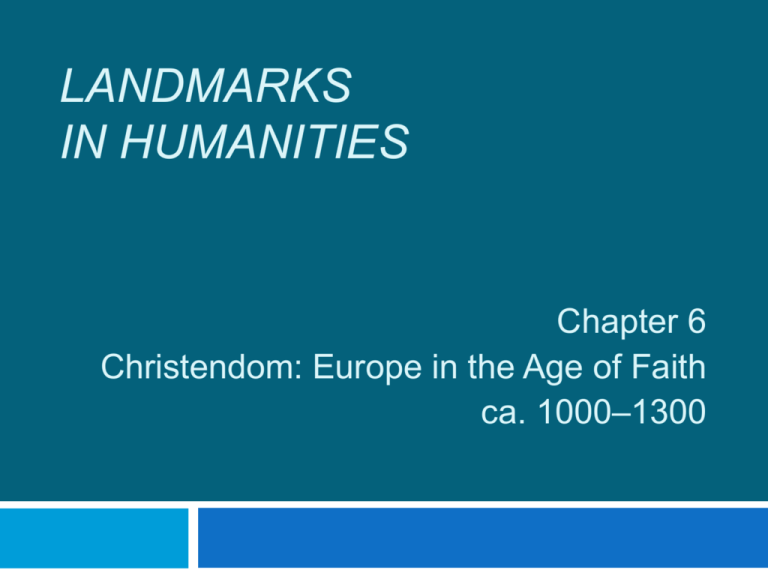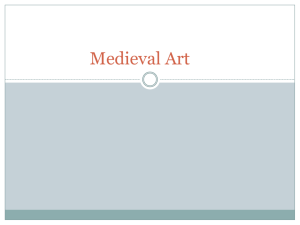
LANDMARKS
IN HUMANITIES
Chapter 6
Christendom: Europe in the Age of Faith
ca. 1000–1300
The Medieval Church
2
The Medieval Church
Roman
Catholic Church held political power
College
of Cardinals
Elected the pope
Curia
Papal council; highest church court
Camera
Papal treasury
Church
wealthy; largest landowner in Western
Europe
©2013, The McGraw-Hill Companies, Inc. All Rights Reserved.
The Medieval Church
3
Church
enforced religious conformity
Excommunication
Interdict
Heresy
grew in response to worldliness of Church
Antiheretical
crusades
Inquisition
Church
also acted as civilizing agent
Church and State
Rivalry
for supreme authority
©2013, The McGraw-Hill Companies, Inc. All Rights Reserved.
The Medieval Church
4
Sin and Salvation
Christian
sacraments assured soul’s redemption
and eternal life
Baptism
Confirmation
Ordination
Matrimony
Penance
Eucharist
Extreme
unction
©2013, The McGraw-Hill Companies, Inc. All Rights Reserved.
The Medieval Church
5
Clergy
held “monopoly” on personal salvation
Remission
from sin
Purgatory
The Literature of Mysticism
Didactic
Record
of an intuitive knowledge of God
Autobiographical
Hildegard of Bingen
Ordo
virtutum
Scivias
©2013, The McGraw-Hill Companies, Inc. All Rights Reserved.
The Medieval Church
6
Saint Francis: Medieval Humanist
Renounced
wealth; practiced absolute poverty
Dedicated himself to preaching and serving
the poor
Rejuvenated idealism of early Christianity
Became known as missionary to all God’s
creatures
Regarded
as a mystic
Canonized in 1228
©2013, The McGraw-Hill Companies, Inc. All Rights Reserved.
Medieval Towns
7
Medieval Towns
Rise
of towns driven by increased agricultural
production and reopening of trade routes
Trade market grew into urban communities
Growth
of the middle class
Profit through commercial exchange
Guilds
established
Municipal governments formed to regulate
economic activity
Stone walls, cathedrals, guildhalls built
©2013, The McGraw-Hill Companies, Inc. All Rights Reserved.
Medieval Towns
8
Medieval Drama
Enactment
Roots
Plays
of Christian history and legend
in religious performance
moved from Church to town square
Pageants
Didactic
entertainment
Mystery
play
Miracle play
Morality play
Ordo virtutum
Everyman
©2013, The McGraw-Hill Companies, Inc. All Rights Reserved.
Medieval Towns
9
Dante’s Divine Comedy
Epic
poem written on both literal and allegorical
level
Journey
through realm of the dead
Spiritual pilgrimage from sin, through purification,
to salvation
Highly
symbolic
Sacred
numerology
Inferno
Hell
with a moral hierarchy and graded system
©2013, The McGraw-Hill Companies, Inc. All Rights Reserved.
Medieval Towns
10
The Medieval University
Shift
from monastic to cathedral schools in urban
centers
Guilds
of students and teachers for higher learning
formed (universitas)
Basic
liberal arts curriculum
Trivium
Quadrivium
Women
excluded
©2013, The McGraw-Hill Companies, Inc. All Rights Reserved.
Medieval Towns
11
Medieval Scholasticism
Sought
to reconcile two primary modes of
knowledge: faith and reason
Synthesis
Sic
of Christian and Classical learning
et Non, Peter Abelard
Balancing
Summa
of opposite points of view
Theologica, Aquinas
Compendium
of all major theological issues
Reason compatible with revelation
©2013, The McGraw-Hill Companies, Inc. All Rights Reserved.
The Pilgrimage Church
12
The Pilgrimage Church
Benedictine
abbey of Cluny spearheaded church
construction and monastic reform
Many new churches enshrined relics
Attracted
Four major routes led to cathedral of Santiago de
Compostela
New churches built along routes
Needed
pilgrims
larger interiors for reliquary chapels
Use of cut stone for vaulting initiated the Romanesque
style
©2013, The McGraw-Hill Companies, Inc. All Rights Reserved.
The Pilgrimage Church
13
©2013, The McGraw-Hill Companies, Inc. All Rights Reserved.
The Pilgrimage Church
14
Romanesque Architecture
Round
arches with stone vaults in upper zones of
nave and side-aisles
Latin cross plan on grander scale
Church of Saint-Sernin at Toulouse
Romanesque Sculpture
Revival
Scene
of monumental stone sculpture
from Bible on entrance portals
Symbolic journey from sin (west) to salvation (east)
Church
of Saint Lazarus at Autun, France
©2013, The McGraw-Hill Companies, Inc. All Rights Reserved.
The Pilgrimage Church
15
©2013, The McGraw-Hill Companies, Inc. All Rights Reserved.
The Pilgrimage Church
16
©2013, The McGraw-Hill Companies, Inc. All Rights Reserved.
The Gothic Cathedral
17
The Gothic Cathedral
Architects
developed new ways for sanctuaries to
soar upward
Served many purposes
Celebration
of Mass
Administrative seat of a bishop
Educational center
Municipal center; focal point for urban community
Honored
saints, especially Virgin Mary
©2013, The McGraw-Hill Companies, Inc. All Rights Reserved.
The Gothic Cathedral
18
The Gothic Style
From
northern France, spread throughout
medieval Europe
Monastic church of Saint-Denis
Abbot
Suger’s design
Pointed arch
Rib vault
“Flying” buttresses
Stained glass window
Filtered the light of divine truth (lux nova)
Latin
cross floor plan
©2013, The McGraw-Hill Companies, Inc. All Rights Reserved.
The Gothic Cathedral
19
©2013, The McGraw-Hill Companies, Inc. All Rights Reserved.
The Gothic Cathedral
20
Chartres Cathedral: Gothic Landmark
Characteristic
Architecture,
Became
Gothic style
sculpture, stained glass
one of Christendom’s most beloved
shrines
Tunic
of the Virgin Mary survived fire
Sculptural
Virgin
Mary dominated iconographic program
Landmark
Notre
program of Old and New Testament
in the art of stained glass
Dame de la Belle Verrière
©2013, The McGraw-Hill Companies, Inc. All Rights Reserved.
The Gothic Cathedral
21
©2013, The McGraw-Hill Companies, Inc. All Rights Reserved.
The Gothic Cathedral
22
©2013, The McGraw-Hill Companies, Inc. All Rights Reserved.
The Gothic Cathedral
23
Medieval Painting: The Gothic Altarpiece
Gothic
architecture spurred creation of painted
altarpieces
Usually
many panels, elevated behind altar
Cimabue, Madonna Enthroned
©2013, The McGraw-Hill Companies, Inc. All Rights Reserved.
Medieval Music
24
Medieval Musical Notation
Invented
in monasteries
Arranged tones of scale in progress; developed
formal system of notating pitch
Benedictine Guido of Arezzo
Staff
of colored lines; neumes
System established precise means of indicating shifts
in pitch
©2013, The McGraw-Hill Companies, Inc. All Rights Reserved.
Medieval Music
25
Medieval Polyphony
Northern
Several
France center of polyphonic composition
lines of melody arranged in counterpoised
rhythms
Pérotin,
three- and four-part Mass
The “Dies Irae”
Reflected
new spirit of dramatic expression
Added to requiem; became standard part of
Christian funeral service
©2013, The McGraw-Hill Companies, Inc. All Rights Reserved.
Medieval Music
26
The Motet
Religious
musical genre
Short,
polyphonic choral composition based on a
sacred text
Juxtaposed
two or more uncomplicated themes
Polytextual, polyphonic, polyrhythmic
Instrumental Music
Medieval
music depended on timbre; instruments
produced gentle and thin sounds
©2013, The McGraw-Hill Companies, Inc. All Rights Reserved.
Beyond the West:
India and China
27
Religious Icons
India:
Hindu icon, Shiva Nataraja, Lord of the
Dance
Venerated
as god of destruction and creation
Embodies rhythms of the universe
China
and Buddhist East Asia: Buddhist icon,
bodhisattva Guanyin
Venerated
as figure of compassion and mercy
(like Virgin Mary)
Protects against the calamities of nature
©2013, The McGraw-Hill Companies, Inc. All Rights Reserved.







